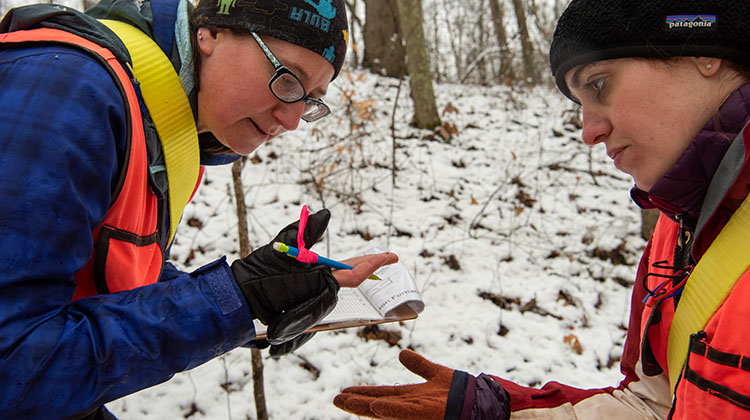Baker Fund awards more than $35K to faculty research in the College of Arts and Sciences

(From left) Dr. Rebecca Snell, an assistant professor of environmental and plant biology, works with graduate student Kelsey Bryant on research at the Vinton Furnace State Experimental Forest. Snell and Dr. Jared DeForest, an associate professor of environmental and plant biology, were awarded $12,000 from the John C. Baker Fund to continue researching how changes in the soil environment affect tree growth. Photo by Ben Wirtz Siegel, BSVC ’02
Four Ohio University faculty members were awarded a total of $35,300 by the John C. Baker Fund during the spring 2020 semester to further their research initiatives.
Named in honor of Ohio University’s 14th president, the John C. Baker Fund was endowed in 1961 by a gift from OHIO alumni Edwin L. Kennedy, AB ’26, HON ’65, and Ruth Kennedy, BSED ’30. Baker Funds are awarded each fall and spring semester to support faculty and staff research, scholarship and creative activity, with preference given to projects that are near completion and that can hopefully be completed with the assistance of these awards.
The Baker Fund Awards Committee received nine proposals, requesting a total of $103,040, for the spring 2020 funding cycle. The following three proposals received funding based on their scholarly, technical or artistic merit:
Why Does Tree Growth Response to Soil Fertilization Depend on the Type of Mycorrhizal Association?
Over the past 30 years, the tree community composition of Eastern North American forests has been shifting from ectomycorrhizal fungi-associated trees, most notably oak trees, toward arbuscular mycorrhizal fungi-associated trees, most notably maple trees.
OHIO College of Arts and Sciences Drs. Jared DeForest, an associate professor of environmental and plant biology, and Rebecca Snell, an assistant professor of environmental and plant biology, were awarded $12,000 to continue researching how changes in the soil environment affect tree growth based on the type of symbiotic association they have with mycorrhizal fungi.
Based on seven years of data, there is evidence to suggest that promoting an inorganic nutrient economy stimulates the growth of trees associated with arbuscular mycorrhizal fungi, such as maple, blackgum and tulip poplars trees, whereas the same nutrient economy suppresses the growth of trees associated with ectomycorrhizal fungi, like oak, beech and hickory trees.
DeForest and Snell, collaborating with seven OHIO students, will collect data on the mineral composition in the leaves and wood of trees to understand if changes in soil nutrient economy affect the nutritional status of trees and can be utilized to understand tree growth responses. Their research will explain how trees are responding to changes in soil nutrients, based on their mycorrhizal association, which will help scientists predict the composition and function of forest communities.
Elucidating the Role of TaVER2 in Wheat Infestation by Hessian Fly
Wheat is the leading source of calories and plant-derived protein in the human diet. The Hessian fly is a significant pest of bread wheat in both North Africa and the United States, damaging $4 million to $20 million annually in wheat crops in South Carolina, Georgia and Alabama between 1980 and 1989.
Dr. Ahmed Faik, an associate professor of environmental and plant biology in the College of Arts and Sciences, was awarded $11,500 from the Baker Fund to study the role of a protein, annotated as TaVER2, in Hessian fly infestation of wheat.
Seeking to complete research funded by two previous National Science Foundation grants, Faik will collaborate with a plant pathologist from Purdue University as well as an undergraduate OHIO researcher to better understand how Hessian fly infestations result in structural changes to the plant that include cell wall thinning, irregular cell wall shape and stunted plant growth. Faik’s hypothesis is that Hessian fly larvae use TaVER2 to affect the integrity of the cell wall by limiting the production of a polymer called xylan, which is directly related to the health and functioning of the plant. This Baker award will help Faik test this hypothesis, which could open the door to new ways of managing Hessian fly infestations in wheat and other cereals and reduce crop yield losses.
Microbe Smiths: Twentieth-Century Japan and the Arts of the Microbial World
In the 20th century, Japanese scientists and skilled workers used microbes’ natural processes to create products like soy-sauce mold starts, MSG, vitamins and statin medication, giving birth to fermentation science found in everything from breweries to the food, fine chemical and pharmaceutical industries.
Dr. Victoria Lee, an assistant professor of history in the College of Arts and Sciences, was awarded $12,000 from the Baker Fund to finish a book presenting a historical analysis of a society where scientists redefined the world’s view of microbes by exploring the “gifts” they could provide to humankind.
Lee’s previous and ongoing research not only illuminates Japanese innovations but reveals the significance of indigenous industries for modern science and technology and the methods they used to create some of the products we still use today. Each of the book’s chapters focuses on a different class of material goods, addressing both contextual developments in Japanese society and comparisons with other national settings. Bringing together an analysis of science, business and environment, Lee’s book gives perspective to the question: How might states and experts manage microbial ecologies, and with what social implications?
After undergoing a peer review at the University of Chicago Press, Lee’s book is expected to be published this fall.
